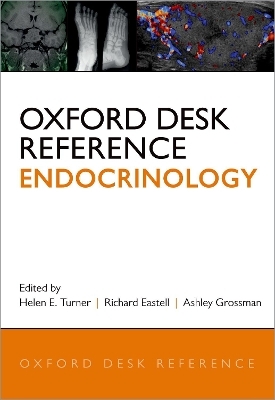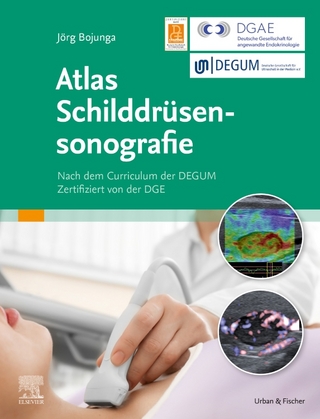
Oxford Desk Reference: Endocrinology
Oxford University Press (Verlag)
978-0-19-967283-7 (ISBN)
Oxford Desk Reference: Endocrinology provides easy access to evidence-based materials for quick consultation but also provides an in-depth expert reference for clinical practice. It covers the process of diagnosis, investigation, and management, as well as information for patients. Internationally-renowned experts have brought together evidence, guidelines and their clinical expertise to put trustworthy support at your fingertips.
The vast spectrum of endocrine disorders are clearly laid out in self-contained topics for easy reference. Chapters build bridges between pathogenesis, clinical presentation, differential diagnosis and investigation to aid understanding. Careful consideration is given to establishing a diagnosis including the recognition, investigation and management of the rarer diagnoses. The practical treatment of everyday endocrine disorders and the management of life-long conditions are outlined in clear protocols.
Chapters are organised by endocrine glands, disorders and syndromes and there are sections on the involvement of hormones in other specialities including endocrine oncology. The continuity from childhood to adolescent and adult endocrinology as well as the needs of older patients is explored in specific sections. Dedicated chapters cover the important roles endocrine specialist nurses play in patient management, and dietetic advice.
The editors have included a wealth of practical resources including:
· A speedy reference section, which provides summaries and quick direction
· A patient advice and reference section, which supports face-to-face discussion with patients
· A medicolegal chapter, which outlines risk and DVLA regulations
Oxford Desk Reference: Endocrinology is the ideal companion for consultants, registrars associate specialists and clinical assistants as well as those from other disciplines who share endocrine clinics including endocrine surgeons, oncologists, gynaecologists and paediatricians.
Dr Helen Turner (MA (Cantab.) MD FRCP LLB Hons) trained at Cambridge University followed by St Bartholomews Hospital, and has been a Consultant Endocrinologist in Oxford since 2000. Her MD research was angiogenesis in endocrine tumours. She has written many research papers and her main clinical and research interests are Turner Syndrome and the Management of Thyroid eye disease. She initiated and edits the successful Oxford Handbook of Endocrinology which is now in its third edition. Richard Eastell qualified in medicine from Edinburgh in 1977. He trained in endocrinology in Edinburgh, Northwick Park and at the Mayo Clinic (Dr B L Riggs). He leads a research group on the pathogenesis, diagnosis and treatment of osteoporosis; of particular note is his contribution to the use of bone turnover markers and the development of treatments for osteoporosis. He was the first European elected to the Council of ASBMR and was its 2013 meeting clinical co-chair. His work has recently been recognised by the Ian MacIntyre Medal (2011), Philippe Bordier Award (2012) (European Calcified Tissue Society), Frederic C Bartter Award 2014 (American Society for Bone and Mineral Research) and IBIS Team Member awarded 2014 Translational Cancer Research Prize, Cancer Research UK, 2014. Ashley Grossman graduated in Psychology and Social Anthropology from the University of London, and then in Neurosciences and eventually Medicine from University College London: he is Professor of Endocrinology and Fellow of Green-Templeton College at the University of Oxford, Professor of Neuroendocrinology at Barts and the London School of Medicine, and Consultant NET Endocrinologist at the Royal Free Hospital, London. His current interests revolve around the pathogenesis of endocrine tumours including adrenal, pituitary and neuroendocrine tumours. He is a Fellow of the Academy of Medical Sciences, and author or co-author of some 850 original articles and reviews.
1 Principles of Endocrinology
1.1: Hormones, Receptors and signalling
1.2: Hormone measurements: Assays
1.3: Hormone measurements: Hormone Binding Proteins
1.4: Hormone measurements: Biological Matrices for Hormone Measurement
1.5: Autoimmunity and the Endocrine System
1.6: Genetic Endocrine Disorders
1.7: Geographic and Ethnic Variation in Endocrine Disorders
2 Thyroid Hormone Metabolism
2.1: Anatomy and physiology
2.2: Thyroid Investigations
2.3: Imaging and Localisation of the Thyroid
2.4: Approach to the assessment of disorders of thyroid hormone homeostasis
2.5: Hyperthyroidism
2.6: Thyroiditis
2.7: Hypothyroidism
2.8: Thyroid Nodules and Cancer
3 Pituitary Gland
3.1: Anatomy and Physiology
3.2: Genetic testing for pituitary adenomas
3.3: Pituitary Imaging and Localisation
3.4: Approach to the assessment of disorders of pituitary hormone homeostasis
3.5: Prolactinomas
3.6: Acromegaly
3.7: Cushing s disease
3.8: Non-Functioning Pituitary Tumours
3.9: Gonadotroph adenomas
3.10: Thyrotrophinomas
3.11: Pituitary Incidentalomas
3.12: Pituitary Carcinoma
3.13: Craniopharyngioma and Perisellar Cysts
3.14: Pituitary Apoplexy
3.15: Surgical Treatment
3.16: Pituitary Radiotherapy
3.17: Parasellar Pituitary Conditions
4 Posterior Pituitary Gland
4.1: Diabetes Insipidus
4.2: Hyponatraemia
4.3: Syndrome of inappropriate ADH (SIADH)
4.4: Disorders of Hypothalamic Function
5 Pineal Gland
5.1: Melatonin and Pineal Tumours
6 Adrenal Gland
6.1: Adrenal Anatomy and Physiology
6.2: Laboratory Investigation of Adrenal Disease
6.3: Imaging the Adrenal Glands
6.4: Primary Hyperaldosteronism
6.5: Mineralocorticoid Hypertension
6.6: Liddle syndrome
6.7: Bartter and Gitelman syndromes
6.8: Cushing s and Subclinical Cushing s Syndrome
6..9: Adrenal incidentalomas
6.1: Adrenal carcinoma
6.11: Addison s disease
6.12: Glucocorticoid replacement
6.13: Autoimmune Polyglandular Syndrome (APS)
6.14: Phaeochromocytoma
6.15: Adrenal surgery
7 Female Hormone Metabolism
7.1: Anatomy and Physiology
7.2: Investigation
7.3: Imaging of Ovarian Tumours
7.4: Polycystic Ovary Syndrome
7.5: Congenital Adrenal Hyperplasia
7.6: Androgen Secreting Tumours
7.7: Primary Ovarian Failure and Premature Ovarian Insufficiency
7.8: Turner syndrome
7.9: Approach to the assessment of disorders of menstrual function
8 Male Hormone Metabolism
8.1: Anatomy and Physiology
8.2: Investigation
8.3: Primary Hypogonadism
8.4: Secondary Hypogonadism
8.5: Erectile Dysfunction
8.6: Gynaecomastia
9 Disorders of Gender and Fertility
9.1: Disorders of sex development (DSD)
9.2: Gender Dysphoria
9.3: Male and Female infertility
10 Endocrine Disorders in Pregnancy
10.1: Thyroid disorders in pregnancy
10.2: Adrenal Disease in pregnancy
10.3: Pituitary Adenomas in Pregnancy
11 Mineral Metabolism
11.1: Anatomy and physiology
11.2: Investigations
11.3: Hypercalcaemia
11.4: Inherited Primary Hyperparathyroidism
11.5: Hypocalcaemia
11.6: Disorders of phosphate homeostasis: Hypophosphataemia including X-linked hypophosphataemic rickets
11.7: Disorders of phosphate homeostasis: Hyperphosphataemia, including tumoral calcinosis
11.8: Disorders of phosphate homeostasis: Chronic kidney disease mineral and bone disorder (CKD-MBD)
12 Bone
12.1: Anatomy and physiology
12.2: Investigation of metabolic bone disease: Biochemical markers of bone turnover
12.3: Investigation of metabolic bone disease: Dual energy X-ray absorptiometry
12.4: Investigation of metabolic bone disease: Plain radiography
12.5: Investigation of metabolic bone disease: Bone biopsy
12.6: Osteoporosis
12.7: Focal Bone Disorders
12.8: Osteogenesis imperfecta
12.9: Sclerosing bone disorders
12.10: Fibrodysplasia ossificans progressiva
13 Endocrine Oncology and Neuroendocrine Disorders
13.1: General introduction
13.2: Neuroendocrine imaging
13.3: Carcinoids
13.4: Insulinoma
13.5: Gastrinomas
13.6: Glucagonomas
13.7: VIPomas
13.8: Somatostatinomas
13.9: Ectopic Hormone Production
13.10: Endocrine Function Following Chemotherapy and Radiotherapy
14 Inherited Endocrine Syndromes and Multiple Endocrine Neoplasia
14.1: McCune-Albright syndrome
14.2: Endocrine Tumours in Neurofibromatosis type 1
14.3: Von-Hippel Lindau Disease
14.4: Carney Complex
14.5: Cowden syndrome
14.6: POEMS syndrome
14.7: MEN1
14.8: MEN2
15 Endocrinology of Metabolism
15.1: Hypoglycaemia
15.2: Obesity
15.3: Eating disorders and starvation
15.4: Sports and endocrinology
15.5: Possible Endocrine Syndromes
16 Hormone Resistance Syndromes
16.1: Resistance to thyroid hormone
16.2: Androgen Insensitivity Syndromes
16.3: Primary Generalised Gluco-corticoid resistance or Chrousos Syndrome
16.4: Syndromes of hormone resistance: ACTH
16.5: Aldosterone resistance
17 Endocrinology of Different Age-Groups
17.1: Adolescents in Endocrinology
17.2: Endocrinology and Ageing
18 Endocrine Investigation, Nursing And Dietetics
18.1: Laboratory investigations in Endocrine Disorders
18.2: The Role of the Endocrine Specialist Nurse
18.3: Endocrine dietetics
19 Patient Advice and Reference
19.1: Diagrams for explanation to patients
19.2: Bone and mineral metabolism
19.3: Clinical Genetics
19.4: Patient support and information resource
20 Speedy Reference
20.1: Indications for treatment of sub-clinical hyperthyroidism
20.2: Differentiated thyroid cancer follow-up
20.3: Indications for GH treatment
20.4: Follow-up of Pituitary Tumours
20.5: Management of Osteoporosis
20.6: Autoimmune Polyglandular Syndromes (APS)
20.7: Investigations in patients with existing autoimmune endocrine diseases
20.8: Hyperglycaemia
20.9: Hyperlipidaemia
20.10: Hypertension
21 Medicolegal Aspects
21.1: Risk explanation
21.2: DVLA regulations
| Erscheinungsdatum | 29.06.2018 |
|---|---|
| Reihe/Serie | Oxford Desk Reference Series |
| Verlagsort | Oxford |
| Sprache | englisch |
| Maße | 177 x 254 mm |
| Gewicht | 1254 g |
| Themenwelt | Medizinische Fachgebiete ► Innere Medizin ► Endokrinologie |
| ISBN-10 | 0-19-967283-0 / 0199672830 |
| ISBN-13 | 978-0-19-967283-7 / 9780199672837 |
| Zustand | Neuware |
| Informationen gemäß Produktsicherheitsverordnung (GPSR) | |
| Haben Sie eine Frage zum Produkt? |
aus dem Bereich


